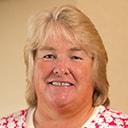May 17
2016
Who Can Turn Your Staff’s “Medical Minds” into “Data-Driven Docs?”
Guest post by Nora Lissy, RN, BSN, MBA, director of healthcare information, Dimensional Insight.

A recent report from Research and Markets predicts that the healthcare data analytics sector will grow to more than $34.27 billion by the end of 2022. This is indicative of how hospitals and health systems are realizing the intrinsic value in an analytics capability—which can be leveraged for everything from capturing information to interpreting the data—to make more informed care decisions. From a provider standpoint however, many physicians are still struggling to close the gap between turning data insights into actionable care improvements. For example, looking at a data set of former pharmaceutical plans for patients with asthma and using the information to make a more informed prescribing decisions for a current patient.
So what can healthcare organizations do to help bridge the divide between the clinical staff and the IT department to make it easier for doctors and clinicians to see how analytics can be applied in their day-to-day care routine? To start, they need to identify which members of their clinical staff have a “data mind” and can easily see how data can be turned into care improvement. For example, looking at an analysis of a hospital’s patient care transitions and adjusting patient handoffs to be more streamlined across departments. A person in this role can communicate to both the clinical and IT sides of the house why data needs to be presented in a certain way and where care adjustments and enhancements can be made.
So how can you find this diamond in the rough who has the ability to turn providers’ “Medical Minds” into “Data Docs” of tomorrow? Here are three tips to help determine who the best person at your organization would be to help fill these shoes:
Who is your organization’s “go-to?”
Who is the one person in your organization/department who everyone goes to with questions? It can be anything from a question about a schedule change or process to a new patient’s medication history. In many cases, this doesn’t even need to be someone from the clinical side or from the IT side. It simply should be someone who has a global view of the organization and who is familiar with the clinical side and has an understanding of what needs to happen on the technical side.
Who has good business intuition?
Someone who has a natural knack in the business world also typically has a data-oriented mindset. This is someone who is not afraid to question the reasoning behind certain recommendations and processes. This is not to say that this individual is counterproductive, but instead is the problem solver. Much like the organization’s go-to contact, this person also sees the full organizational picture rather than just through the lens of the department that they work for and are instilled with ability to translate the business and operational needs into the technical needs.
Who makes continuing education programs a priority?
Continuing education courses are extremely common with treatment plans and new medications continuing to change the way that care is delivered. Similar programs are also available for providers who are looking to better understand IT capabilities. For example, Florida International University offers a master’s program in health informatics and analytics for healthcare workers. By offering providers this type of course education, it allows clinicians to fully understand the technology that they are using everyday as well as how the data can be leveraged to enhance care decision making. This type of program focuses on helping the healthcare provider to have a high level understanding of the technology in order to bridge the communication gap between IT and non-IT professionals. Additionally this gives clinical staff the opportunity to learn how to use today’s advanced information systems to create more efficient and productive healthcare environments. Rather than simply asking an IT staff member to answer an analytical question with a “canned” or specialized report, providers inherently become a part of the journey of turning data-driven insights into improved care decisions.
As we continue to see an increase in the number of healthcare organizations adopting a data analytics platform, it is becoming increasingly important that providers know how to incorporate these data insights into their care programs. By determining the best liaison between the clinical staff and the IT staff at a healthcare organization, clinicians will be able to see first-hand how to speak the language of a data doc and how to use these data insights to ultimately improve how care is delivered.